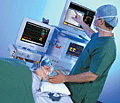WeInterpret.Net has signed a contract with the University of Maryland Medical System (UMMS) and has been providing sign language interpreting services to both the University of Maryland Medical Center and the University Specialty Hospital, both in Baltimore. The additional seven member hospitals have now been added to the contract. Located in Baltimore City and Glen Burnie, along with Cambridge, Easton, and Chestertown on the eastern shore, the list of participating hospitals includes Maryland General Hospital, Baltimore Washington Medical Center, Mt. Washington Pediatric Hospital, Memorial Hospital at Easton, Chester River Hospital Center, Dorchester General Hospital, and the James Lawrence Kernan Hospital. As one of the largest hospital networks and related clinic services in Maryland, hundreds of patients each year require interpreting services to communicate successfully with hospital staff and medical personnel. WeInterpret.Net, providing interpreting services throughout the state of Maryland and in many locations across the country, is pleased to have been chosen by the University Medical System to provide services 24 hours a day, 7 days a week. Nationally Certified and Qualified Interpreters provided by WeInterpret.Net assure that the hospital is in compliance with the Americans with Disabilities Act of 1990. which requires equal access through appropriate methods of communication.
Appropriate communication methods vary by individual and We Interpret.Net can provide interpreters skilled in American Sign Language, Signed English, The Rochester Method, Cued Speech and Oral Interpretation. In areas such as the Washington / Baltimore metro area, interpreters are in high demand and short supply. “Full-time staff interpreters along with managers who are also certified interpreters, allows the agency to respond to every request with qualified interpreters even on the busiest of days or during the overnight and weekend hours,†stated Tauna Faries, Vice President of Operations for WeInterpret.Net.
About WeInterpret.Net
Maryland Interpreting Services, a Maryland corporation doing business as WeInterpret.Net and WeInterpretLinked was established in 1996. Owner and President, David Stephenson is a nationally certified interpreter. Since its establishment, it has provided some 6 million hours of interpreting services to some 900 customers through offices in Utah, Virginia, Maryland and New Mexico. Staff Interpreters and Independent Sub-Contractors numbering over 1000 provide On-Site (www.WeInterpret.Net) and Video Remote Interpreting. (www.WeInterpretLinked.com)
About University of Maryland Medical System
The University of Maryland Medical System (UMMS) was created in 1984 when the state-owned University Hospital became a private, nonprofit organization. It has evolved into a multi-hospital system with academic, community and specialty service missions reaching every part of the state and beyond. (www.umm.edu) UMMS is a national and regional referral center for trauma, cancer care, neurocare, cardiac care, women’s and children’s health and physical rehabilitation. It also has one of the world’s largest kidney transplant programs, as well as scores of other programs that improve the physical and mental health of thousands of people daily.
Via EPR Network
More Healthcare press releases





